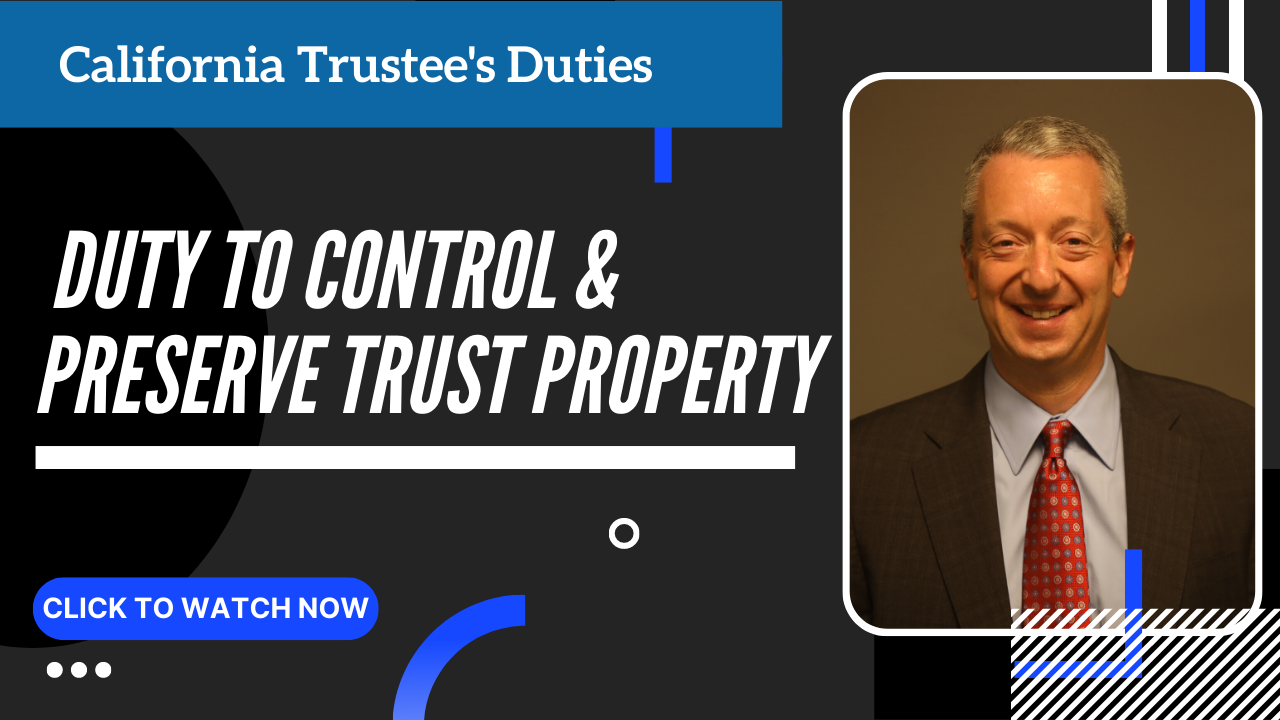Trustee Duties: Should My Trustee Protect and Preserve Trust Property?
Do you have a trust and are concerned your trustee has not been adequately controlling your trust property? Do you feel your trustee is not working in your best interest and actively preserving trust property? You may have good reason to think that way. As a beneficiary, it is significant to know a trustee’s duties to maintain trust property and when the person put in charge of the trust is not working effectively. So how does a trustee protect and preserve trust property?
Here at The Grossman Law Firm, we know what a trustee who is not doing their duties of controlling and preserving trust property looks like.
With over twenty years in service in California, we have guided our clients on their rights as a beneficiary, removing trustees and helping our clients understand the trust litigation process.
In this article and video, you will learn about a trustee’s duties to protect and preserve trust property:
- Taking and keeping control of trust property
- How should a trustee preserve a trust property?
- Why is this important for proper trust administration?
 Taking and keeping control of trust property
Taking and keeping control of trust property
The trustee’s duty to take and keep control of trust property is fundamental to proper trust administration. According to California trust laws, trust administration is the process that a trustee must adhere to.
And without proper trust administration, taking and keeping control of trust property would be unmanageable. So, you may wonder, what does controlling and preserving trust property look like?
A trustee takes control of trust property by titling or naming it in the name of the trust. For a trustee to take control of any financial assets, such as bank accounts, brokerage accounts, and any mutual funds, they would contact the financial institution and inform the institution that a new trustee’s providing them with the documents they require to change the title.
So what does it look like when a trustee is not properly preserve and control of the trust?
Let us say the trust receives money from the settlor’s death (like from life insurance or a payout from a pension plan). That money must go into a trust-owned account. The trustee cannot put it into an account they own as an individual. This act of putting money into an individually owned account when it should go into the trust’s account breaks several duties of a trustee.
However, some assets require more work when keeping control of trust property.
For example, the trustee must physically secure assets of significant value, such as expensive jewelry, artwork, or any collection of value, from guns to baseball cards.
The way in which a trustee secures physical valuables depends on the assets and their value. If there are paintings valued at a few thousand dollars hanging in the deceased trust settlor’s home, and you chose to leave them there with a security system and recently changed locks to the house, then that is a reasonable way of controlling trust property.
For instance, there are tens of thousands of dollars of jewelry, then a security system and changed locks wouldn’t do. So for instance, the strength of the security system should be comparable with the value of the assets. The jewelry should be removed from the home and sealed in a safe deposit box, ensuring it is secure and protected.
How Should a Trustee Preserve the Trust Property?
Preservation can mean many things. Financial assets, for instance, do not require any work to preserve.
Tangible items, however, may require some upkeep to be preserved. For example, real estate and cars require consistent maintenance to maintain their value. And up-keeping is employed to preserve the value of the trust property. For example, real estate and cars require consistent maintenance to maintain their value.
Preservation may also require limiting access to the trust-owned property.
A scenario to consider could be a foreseeable accident. A foreseeable accident is when an accident can be assessed by actual circumstances. So it is an event that can be foreseen, and can possibly be a breach of fiduciary duty. That can mean not having a security system in place to protect your assets. This can mean having valuables such as a car, art, jewelry, gold, and other rare material, in your residence, knowing your disinherited sibling has a violent past and might break in.
Or let us say you and your brother are working on a home renovation project together, and you let him borrow the car owned by the trust. But on his way to the store, he was in an accident. Since you let him borrow the car and he was in an accident, this creates a liability for the trust.
Why is proper trust administration important?
Protecting and preserving trust property is significant for proper trust administration. When a trustee improperly controls and preserves trust property, that can affect your inheritance. Meaning it can affect how much money you collect in the long run.
If your trustee is not controlling and preserving trust property effectively, this is a breach of the trustee’s fiduciary duty. This breach of their fiduciary duty will inevitably reduce your inheritance.
Know the basics of proper trust administration
If you would still like some more information on Trust Litigation and removing a trustee, check out our complete Overview of California Trust Litigation, available on our website. And if you have more questions about your rights as a beneficiary and what you should know moving forward. Please review our articles on the Beneficiary’s Rights in California and the Prudent Investor Rule, or check Investopedia’s article for a more thorough look at the Prudent Investor Rule and your rights as a beneficiary.
Or if you are still having some trouble or have any more questions, or want to talk to someone about your case, please give us a call or fill out our Get Help Now form.